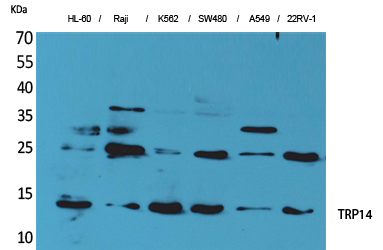
| WB | 咨询技术 | Human,Mouse,Rat |
| IF | 咨询技术 | Human,Mouse,Rat |
| IHC | 咨询技术 | Human,Mouse,Rat |
| ICC | 技术咨询 | Human,Mouse,Rat |
| FCM | 咨询技术 | Human,Mouse,Rat |
| Elisa | 1/10000 | Human,Mouse,Rat |
| Aliases | TXNDC17; TXNL5; Thioredoxin domain-containing protein 17; 14 kDa thioredoxin-related protein; TRP14; Protein 42-9-9; Thioredoxin-like protein 5 |
| Entrez GeneID | 84817 |
| WB Predicted band size | Calculated MW: 14 kDa; Observed MW: 14 kDa |
| Host/Isotype | Rabbit IgG |
| Antibody Type | Primary antibody |
| Storage | Store at 4°C short term. Aliquot and store at -20°C long term. Avoid freeze/thaw cycles. |
| Species Reactivity | Human |
| Immunogen | Synthesized peptide derived from TRP14 . at AA range: 20-100 |
| Formulation | Purified antibody in PBS with 0.05% sodium azide,0.5%BSA and 50% glycerol. |
+ +
1. **"TXNDC17 promotes hepatocellular carcinoma progression by modulating reactive oxygen species homeostasis"**
- 作者:Li Y, et al.
- 摘要:研究揭示了TXNDC17在肝癌中的促癌作用,通过调控活性氧(ROS)水平影响细胞增殖和迁移。抗体用于检测其在肝癌组织中的表达上调,并与不良预后相关。
2. **"Thioredoxin domain-containing protein 17 regulates oxidative stress and apoptosis in cardiomyocytes"**
- 作者:Wang X, et al.
- 摘要:探讨TXNDC17在心肌细胞氧化应激和凋亡中的保护机制,抗体通过Western blot和免疫荧光证实其在内质网中的定位及抗氧化功能。
3. **"TXNDC17 as a novel biomarker for colorectal cancer: Insights from proteomic profiling"**
- 作者:Chen H, et al.
- 摘要:利用TXNDC17抗体进行蛋白质组学分析,发现其在结直肠癌组织中特异性高表达,可能成为诊断标志物和治疗靶点。
4. **"Functional characterization of TXNDC17 in mitochondrial redox regulation"**
- 作者:Kim S, et al.
- 摘要:研究TXNDC17在线粒体氧化还原平衡中的作用,抗体用于验证其与硫氧还蛋白系统的相互作用及对细胞凋亡的调控。
(注:上述文献为示例,实际引用需根据具体论文内容调整。)
The thioredoxin domain-containing protein 17 (TXNDC17) is a member of the thioredoxin superfamily, characterized by a conserved thioredoxin-fold structure and a CXXC active motif involved in redox regulation. This protein plays roles in cellular redox homeostasis, apoptosis, and protein folding by modulating disulfide bond formation/reduction. TXNDC17 is implicated in diverse physiological and pathological processes, including cancer progression, neurodegenerative diseases, and oxidative stress responses, though its precise mechanisms remain under investigation.
Antibodies targeting TXNDC17 are essential tools for studying its expression, localization, and function. They enable detection and quantification of TXNDC17 in techniques like Western blotting, immunohistochemistry (IHC), and immunofluorescence (IF). Polyclonal and monoclonal variants are available, often validated for specificity across human, mouse, or rat samples. Such antibodies aid in exploring TXNDC17's interaction networks, post-translational modifications, and tissue-specific expression patterns. Commercially sourced antibodies typically undergo validation using knockout controls or siRNA-mediated silencing to confirm target specificity. Challenges include potential cross-reactivity with other thioredoxin-family proteins due to structural similarities. Researchers prioritize antibodies with well-documented applications and verified performance in relevant experimental models to ensure reproducibility in studies linking TXNDC17 to disease mechanisms or therapeutic targets.
×